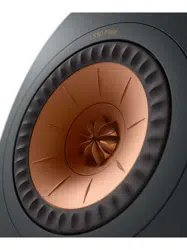Loading ...
Loading ...
Loading ...

2 3
The most important innovation in this loudspeaker
is the near-perfect absorption of the unwanted rear
sound generated by the tweeter dome. One might
legitimately ask, “Why is this important?”
It’s true that, if the tweeter is listened to on its own
without the contribution of the bass/midrange driver
- and here we are talking of frequencies above about
3kHz - very little seems to come out of it. More
revealing is to listen to any loudspeaker system
without the tweeter connected. The sound is mufed
and, although one can discern that it’s a piano or a
violin playing, it’s impossible to hear the difference
between a Steinway and a Bosendorfer, a Stradivarius
and an also-ran violin.
The true music lover or audiophile wants to hear this
amount of detail. More than that, one should be able
to imagine the striking of the keys or the way the bow
is stroking the strings. In short, it should be the closest
one can get to a live performance without actually
turning up.
This sort of detail comes from the tweeter and
the better the tweeter, the more the enjoyment of
listening to the music.
Metamaterials
Metamaterials are probably most familiar in the eld
of optics, where synthetic materials may be realised
that have properties that cannot be found in nature.
For example, a base material may be infused with
another in varying density such that the refractive
index varies throughout the material. Thus things like
at lenses may be constructed that are much easier to
produce than grinding glass to a precise shape.
The term “meta” has since gained the more general
description of any material that exhibits characteristics
foreign to the solid form. In this case, ABS has been
moulded into a shape that is an almost ideal broad-
band absorber.
The design of the absorber was a joint project between
KEF and AMG (Acoustic Metamaterials Group).
With the help of Professor Ping Sheng (a world-
renowned expert on metamaterials), AMG derived
the mathematical expression between the target
absorption spectrum and the physical realisation,
which has a minimum thickness only 1/10th of the
wavelength at the lowest frequency (620Hz in this
case).
Tweeter Metamaterial
Absorption Technolology
Figures 3 and 4 respectively show a computer model
of the absorber and the real thing. Its design borrows
from a room acoustics absorber in that it is based
around ¼ wavelength resonators. Looking rather
like a maze, what you can see are 15 separate tubes,
folded up to make a circular object. In fact, there are 2
layers, so there are, in total, 30 tubes, each tuned to a
different frequency.
Each tube has a very high Q, which means high
absorption over a very narrow band, and the only
damping, which is the way the energy is dissipated,
comes from the friction between the air moving in
the tubes and the tube walls. The frequency spacing is
designed so that, when the effects of all the tubes are
combined together, the absorption is uniform over a
wide band.
Figure 5 shows the pressure response, measured at
the closed end of each of the 30 channels, together
with the absorption spectrum of the whole absorber.
These are steady-state measurements and anyone
who is familiar with lters will know that, although
the amplitude response of narrow-band lters may
well add to unity, this usually hides the presence of all-
pass phase responses and some time smearing occurs.
The system is said to be non-minimum phase. This is
the case with the summing of the transfer functions
of the separate channels of graphic equalisers and
the outputs of two or more drivers fed by a passive
speaker crossover network. Such time smearing can
readily be shown by impulse measurements, where a
change in prole between the exciting signal and that
generated by the device(s) indicates time smearing.
Figure 3
Computer model of absorber
Figure 4
Actual absorber
Figure 5
Top: pressure response at closed end of each separate absorber channel.
Bottom: absorption spectrum of whole absorber.
Figure 7
Top: Amplitude and Phase responses of transfer functions
V1 (green), V2 (blue) and V1+V2 (red).
Bottom: Amplitude and Phase responses of input impedance
Figure 6
Generalised 3rd-order Butterworth constant-resistance
crossover. Units are Ohms, Farads and Henries. fc is cut-off
Loading ...
Loading ...
Loading ...
